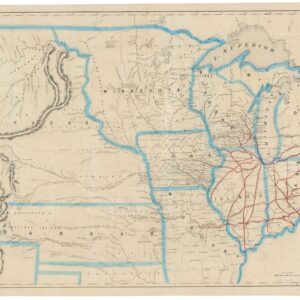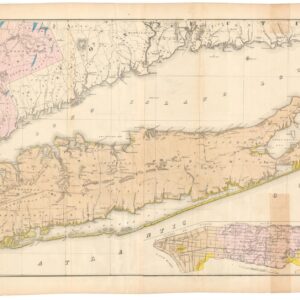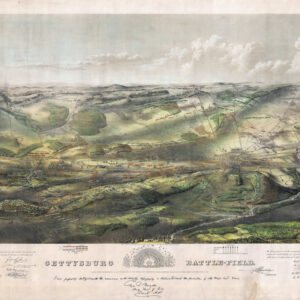A formative sheet in patriotic printing.
[Untitled] Portraits and facsimile signatures of 48 American patriots.
$3,500
In stock
Description
This rare and untitled lithographic sheet, printed in the early 1840s, depicts portraits and facsimile signatures of many of America’s Founding Fathers. Emphasis is on the brave congressional representatives who signed the Declaration of Independence, which is also the document from which most of the signatures have been replicated. The portraits are rendered in a light and realistic style that strives to capture the atmosphere of the event and the correct appearances of late 18th century American dignitaries.
The signatures are shown in eight columns, each linked to its specific portrait by a number. There are 48 signatures and portraits in total. Of these, only 43 signed the final Declaration of Independence. The last five are nonetheless closely associated with the American Revolution, and their inclusion underscores that this document was meant to capture the patriotism of these figures rather than the presence of their signatures.
Census
There are no apparent listings in OCLC or other institutional databases of this particular sheet. Being untitled and seemingly not attributed to a specific artist or printer, any exact parallels are difficult to identify. However, even though we have not found other examples of this sheet, we have identified a parallel that allows us to fix its origin and date.
In 1842, the New York Mirror issued a steel-engraved scene commemorating the events that created the American Republic. On the front was John Turnbull’s iconic but apocryphal painting of the signing of the Declaration of Independence, while the verso contained the facsimile portraits and signatures of the signatories. While the portraits appear to be similar if not identical to our sheet, something changed in the layout, which meant that the final product was issued with the signatures in five columns, in stead of the eight columns in our example. Underneath the portraits and signatures we find the full text of the Declaration of Independence printed, explaining why the portraits and signatures alone take on the oblong dimensions seen in Neatline’s sheet.
The most likely explanation is that our sheet constitutes a preliminary state, presumably produced as part lay-out and typesetting process for the final print. It may also have been to test or proof-print variants of the individual components in this composite image. The latter option is particularly underscored by the fact that we have learned of another example in which the signatures have been arranged in six columns.
In the final etching issued by the New York Mirror in 1842, the printed area covered only 25 by 33 cm of the 40 by 49 cm sheet. The composition of the verso showed the signatures in five columns and included the Declaration’s text below. While it was based on Turnbull’s painting, the vivacious engraving was done by J.F.E. Prud’Homme. The full engraving can be found in the archives of The American Antiquarian Society (Catalog Record #394404).
We also note that the commercial memorabilia company The History List retains the printing rights to reproduce and sell an example of the sheet (https://store.thehistorylist.com/products/the-signers-of-the-declaration-of-the-independence-and-their-signatures).
Based on the apparent progression between our sheet and the final product, we believe that Neatline’s example constitutes a preparatory sheet relating to the design process. Whether our version was ever published for wider distribution is unclear, although the lack of institutional parallels makes it unlikely.
Context is Everything
The five figures on this sheet who did not sign the final version of the Declaration of Independence were, nevertheless, Founding Fathers in their own right. Each one played a decisive role in creating an independent and viable United States, and it is clear that the author of this highly patriotic piece of memorabilia felt that they deserved to be included in the lineup. The five additional men – George Clinton (8), Thomas Willing (18), Robert R. Livingston (33), Charles Thomson (42), and John Dickinson (45) – are identified on the sheet by an asterisk in front of their names.
Because the sheet is rare and undated, their inclusion helps us identify the most likely historical setting in which it was created. They were all-important men directly associated with the American Revolution. George Clinton was the fourth vice-president and served until his death in 1812. Thomas Willing was a merchant and slave trader with political interests who served as mayor of Philadelphia. He was also a Pennsylvania delegate to the Continental Congress. In 1821, he was the last of the five to die. Robert Robert Livingston was a lawyer and diplomat from New York and a member of the Committee of Five that drafted the wording of the Declaration of Independence (with Thomas Jefferson, Benjamin Franklin, John Adams, and Roger Sherman). Livingston also administered the oath of office to George Washington when he assumed the presidency in 1789. Charles Thomson served as Secretary of the Continental Congress throughout its existence and as Chief Executive of the American Government a number of times up until 1789. And finally, John Dickinson was an attorney from Philadelphia known as the “Penman of the Revolution.” Among his most famous writings are Letters from a Farmer in Pennsylvania and Liberty Song.
While these five men indubitably belong to the pantheon of admired patriots who fought for American independence, their inclusion signets that this sheet was conceived after 1821. Following the victory over the British in the War of 1812 (1812-1815), an inflated sense of nationalism overcame America, which often was expressed in the guise of romantic patriotism. An explosion in both visual and literary printed matter occurred during this period. We believe our elongated sheet is part of this patriotic manifestation in the arts. From the published parallel in the New York Mirror in 1842, we place its creation around 1840. Once the trend began to take hold, printed sheets with the signers of the Declaration of Independence started appearing in many different versions and formats. But rarely would these include people who had not put their names to the final document.
Cartographer(s):
Condition Description
Backed with old linen. Some light soiling, staining and creasing; very good.
References





